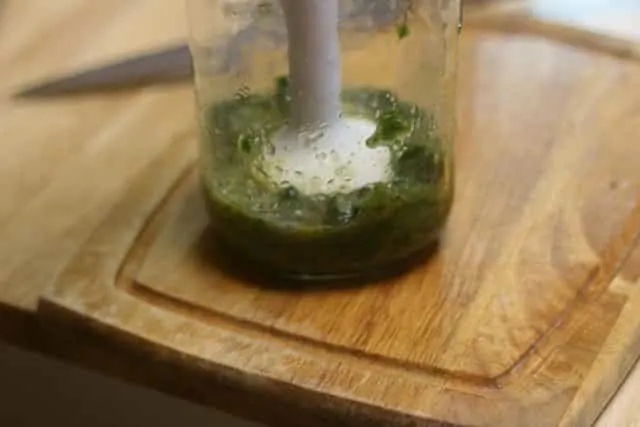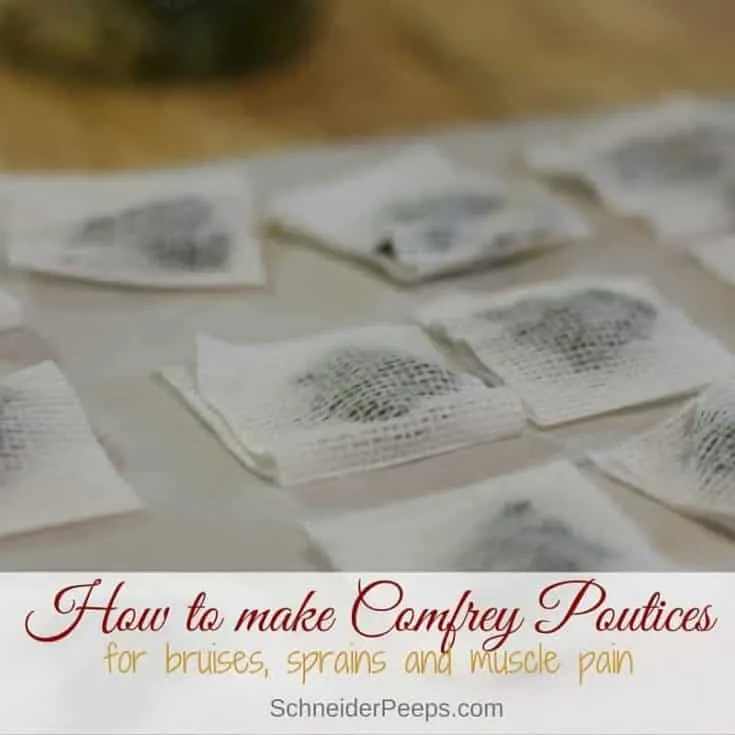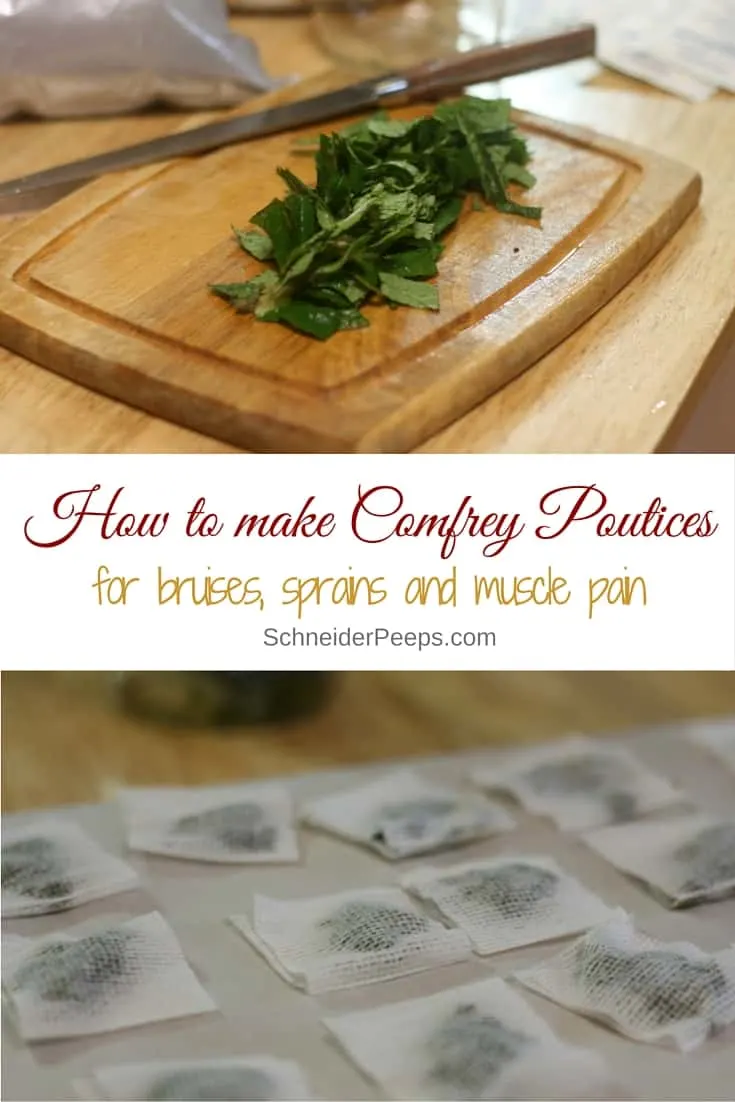Poultices are a staple in our homemade first aid supplies. I like to keep a few homemade comfrey poultices on hand for when we need them and I’m going to show you how you can make them in advance too.

A few years ago our oldest daughter bruised her big toe at dance (pointe ballet). She has no idea how it happened, it looked like someone dropped something heavy on it, the entire toenail was purple and blue.
And it hurt.
You know, the kind of hurt that when someone accidentally bumps it you start doing that silent cry that just won’t stop. Yep, that kind of hurt.
We don’t normally treat bruises in our family, especially since they are usually from a bump or playing paintball. But this one was different than most bruises, so after reading up on bruises, I decided that we needed to try a comfrey poultice.
Fortunately, I just happen to grow comfrey in our garden. So, I headed out to the garden and picked four comfrey leaves and then got to work. I knew that she would need to keep up the comfrey treatment for a few days but I didn’t want to make it each time she needed it.
I decided I would make some small poultices and freeze them. Comfrey is best used fresh, but when it’s a choice between using frozen comfrey poultices regularly or using fresh comfrey poultices irregularly, the choice is easy. The convenience of frozen comfrey poultices outweighs the benefits of fresh comfrey poultices for me.
If you don’t already, I want to encourage you to keep notes on each herb that you learn about. I use an herb profile worksheet for each herb. You can get a copy of this worksheet emailed to you by filling out the form below.
How to Make a Comfrey Poultice
To make a comfrey poultice for the freezer, you’ll need….
- comfrey leaves
- cutting board
- knife
- wide mouth mason jar
- immersion blender
- phyllium husks
- gauze pads
There’s a printable page at the bottom of the post that you can print out and put in your wellness notebook. The printable page has all the instructions and ingredients for making a comfrey poultice.

Once you have the comfrey leaves, rinse them off under cool water.
Roughly chop the leaves and put them in a wide mouth mason jar.
Add enough water to just barely cover them and add a tsp of psyllium husks to thicken it up so that it doesn’t just slide all over the place.

Used an immersion blender to blend it all up and make a paste.

Open up some gauze pads and put a small spoonful of the comfrey poultice on each one. Once they were all full close them up and put them in the freezer for a couple of hours.
When the comfrey poultices are frozen, put them in a freezer container and put them back in the freezer.
When one is needed, we can just pull it out and let the body heat thaw it out.
How to Use a Comfrey Poultice
Whether you’re using a fresh comfrey poultice or a frozen one, once they’re made, you use them exactly the same. You’ll take the poultice and put it on the affected area – bruise, sprain, bee sting, etc.
I like to cover the poultice with a waterproof gauze pad and tape it securely. If the affected area is on a wrist or ankle we usually just wrap the area with a roll of gauze instead of using tape.
Change the poultice several times a day.
Comfrey Safety Precautions
Comfrey has been used for hundreds of years both internally and externally. However, it’s been found that comfrey can cause liver damage when used internally, so don’t take comfrey internally. That also means, don’t use comfrey on an open wound as it can more easily seep into your blood stream.
I realize that there is some controversy over the studies that lead to the recommendation to not use comfrey internally. If you are comfortable using it internally, that’s your business. However, I choose to err on the side of caution, especially when there are other herbs that are safe and can be used for the same concerns that comfrey can be used for.
Don’t use comfrey on small children. Their smaller bodies have a much harder time processing toxins than larger bodies.
It’s best to only use comfrey for 4-6 weeks in one calendar year.
It’s also best to also take some liver supporting herbs while using comfrey, like drinking moringa tea or adding moringa to smoothies. Other liver supporting herbs include valarian, dandelion, burdock root, lemon balm, milk thistle, turmeric, and yellow dock, be sure to do your research before taking medicinal amounts of any herb.
Of course, I think the best place to get your comfrey is to grow it yourself, you can get quality root stock from Buy Comfrey. It’s a super fast growing plant but if you just can’t wait you can order it.
If you’re interested in studying herbs in depth, I highly recommend the courses from The Herbal Academy.
Easy Comfrey Poultice

Comfrey poultices are great for sprains, bruises, insect bites, and many other inflammation issues.
Materials
- comfrey leaves
- psyllium husks
- gauze pads
- water
Tools
Instructions
- Once you have the comfrey leaves, rinse them off under cool water.
- Roughly chop the leaves and put them in a wide mouth mason jar.
- Add enough water to just barely cover them and add a tsp of psyllium husks to thicken it up so that it doesn't just slide all over the place.
- Used an immersion blender to blend it all up and make a paste.
- Open up some gauze pads and put a small spoonful of the comfrey poultice on each one. Once they were all full close them up and put them in the freezer for a couple of hours.
- When the comfrey poultices are frozen, put them in a freezer container and put them back in the freezer.
- When one is needed, we can just pull it out and let the body heat thaw it out.
Notes
How to use a comfrey poultice:
Put a frozen or slightly thawed comfrey poultice on the affected area - bruise, sprain, bee sting, etc.
Cover the poultice with a waterproof gauze pad and tape it securely.
If the affected area is on a wrist or ankle we usually just wrap the area with a roll of gauze instead of using tape.
Change the poultice several times a day.

Tell me, do you use herbal poultices? If so, what do you use and for what?

Mary
Tuesday 31st of October 2023
Can these be refrozen and reused or is it a once and done? Love the idea!
Angi Schneider
Thursday 2nd of November 2023
Honestly, I have no idea. We just use them once.
Lili
Monday 14th of September 2020
Thanks for your article Angi. I've read elsewhere that somebody used a comfrey, goldenseal and colloidal silver poultice for a hernia and, as a side-effect, they also found that it stopped their monthly recurring uterine prolapse. I've got this uterine prolapse problem too along with rectocele and cystocele, so I've gathered some comfrey but don't have the other ingredients (although I do have the slippery elm - thanks to Mark and Linda above I'll try that) and am real glad for your article on how to make (and freeze) the poultices. Who knows if it will work for me, but I'm eager to find out :)
Denise
Sunday 11th of April 2021
Hi Lili, I'm curious how the comfrey treatments are helping your rectocele and cystocele. I have both of those, too. I just started applying comfrey oil to them because that's what I have that's convenient. If you've had any other kinds of success treating those, I'd love to hear about it. Thanks! :)
Angi Schneider
Saturday 19th of September 2020
I'm hoping it works for you, Lili!
Mark & Linda
Friday 24th of July 2020
Angi, thank you SO much for this post. Using gauze, freezing and using an immersion blender were genus! (Other blenders do not work as well - I've tried.) A couple tips for your readers: 1) You can use slippery elm bark as your binding agent. (We learned this from master herbalist Richard Schultze) It works great for poultices and you can find it online in a powdered form. It can also be taken internally and is a wonderful soothing agent for things like Crohn's disease. We have made poultices with slippery elm that did not require any external bandaging. The poultice just sticks until it dries all the way through, at which point it falls off. Very cool. 2) Consider using the Comfrey poultices for external hemorrhoids and during recovery from an excisional hemorrhoidectomy. A good percentage of the population will experience these and Comfrey works wonders..
Angi Schneider
Friday 24th of July 2020
Thanks for sharing your knowledge and tips! I love that we can all learn from each other. Now, to go find some slippery elm bark...lol
Janet
Thursday 8th of August 2019
You mention the possible effects of taking comfrey internally. I found that a lot of people are not aware of a hybridized version of comfrey that is safe to use internally. Here's a link to an article on it. that I thought I'd pass along. http://www.susunweed.com/herbal_ezine/June08/wisewoman.htm
Angi Schneider
Wednesday 14th of August 2019
Thanks for the link to the article, Janet. I always think it's good for people to do their own research and make decisions they are comfortable with. The more information, the better.
That being said, the comfrey that is mentioned in my article on growing is the cultivated comfrey. However, I would still caution that if there are other herbs that will give the same benefits without the possibility of causing liver damage, those are the herbs that should be used. The thing about liver damage is that it's silent until it's irreversible. Many alcoholics believe their liver is just fine....until one day it isn't. There are no warning signs that someone is slowly damaging their liver. Because of this, I would never recommend that someone use comfrey, any comfrey, internally unless they do so under the supervision of a trained herbalist, for very specific issues, and for a limited amount of time. I realize that Susan Weed is a very respected in the herbal community, I have respect for some of the work she has done to educate people, however, I disagree with her on the unlimited, preventative usage of comfrey. There are many other herbs that can be used in this way that are just as effective as comfrey.
I do appreciate you taking the time to leave a comment and provide the link to additional information about using comfrey internally.
Joy Pearce
Sunday 17th of March 2019
Comfrey can be used in the garden, good for compost bins, and for putting in the bottom of hanging baskets, pot plants, and yes havest the older leaves, looks nice when in flower.
Angi Schneider
Sunday 17th of March 2019
Thanks for the tips, Joy. I hadn't thought of using it in the bottom of potted and hanging plants.